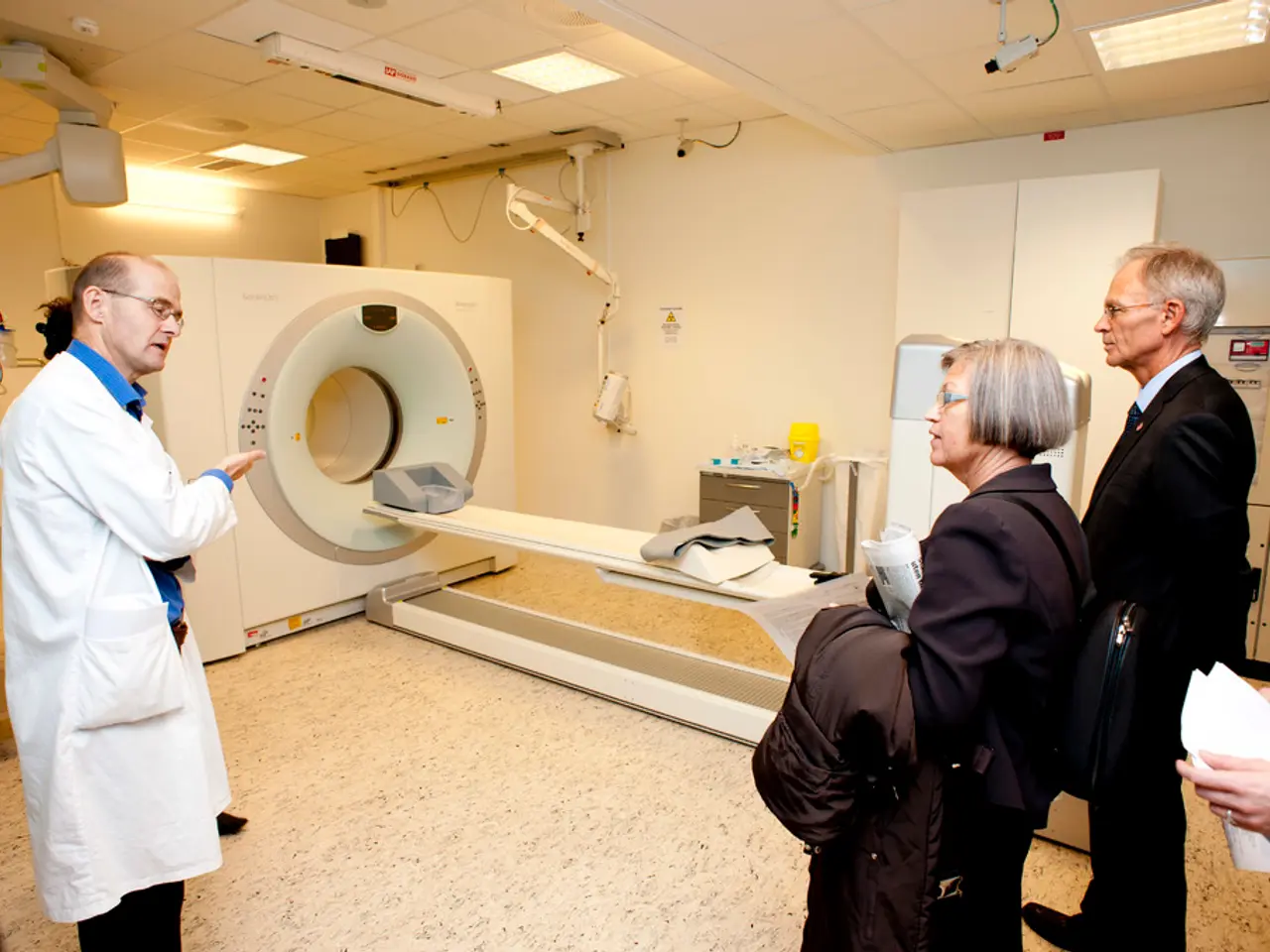MRI Scan of the Skull: Explanation of Purpose, Outcomes, and Typical Experiences
Head MRI scans play a crucial role in diagnosing and monitoring a wide range of neurological and brain-related conditions for both children and adults. This article provides an overview of the common uses, procedure, and preparation for a head MRI scan.
**Common Uses of Head MRI Scans**
Head MRI scans are employed for various purposes, including injury and abnormalities detection, tumor and cyst identification, neurological symptoms evaluation, infection and inflammation diagnosis, vascular issues detection, chronic conditions monitoring, developmental and congenital anomalies assessment, and surgical or treatment planning.
**How the MRI Procedure is Performed**
During an MRI scan, the patient lies on a motorized table that slides into a large, cylindrical MRI scanner. The scanner creates a strong magnetic field that aligns the body's protons, followed by the emission of radiofrequency waves. When the waves stop, protons return to their original alignment, releasing energy that is used to create detailed images of brain tissues and structures.
In some cases, a contrast agent is injected intravenously to enhance image detail, particularly useful for tumors, inflammation, or blood vessel evaluation. The procedure is non-invasive and typically lasts from 20 minutes up to an hour, depending on the complexity.
**Preparation and What to Expect**
Preparation for an MRI scan is usually minimal. Patients should avoid wearing metal objects such as jewelry, belts, zippers, or underwire bras. Clothes without metal fasteners are preferred, or a hospital gown may be provided.
For children, special preparation might include explaining the procedure to reduce anxiety, and in some cases, sedation may be necessary for younger or less cooperative children to remain still during the scan safely and effectively.
During the scan, the patient lies still inside the scanner, which may feel confining but is painless. Communication with the medical staff is maintained via an intercom. Instructions may be given to hold breath or remain still during certain imaging phases.
After the scan, there are generally no side effects or recovery period unless sedation was used. Patients can resume normal activities immediately.
**Additional Considerations**
- Depending on the purpose of the scan, a person may be asked to take contrast, a substance that helps the images to be more clearly defined. - If a person has extreme claustrophobia, anesthetics or sedatives may be offered. - If a person has trouble lying still, a technician may offer restraints to help. - There is a small chance that a person may have an allergic reaction to contrast materials. - Several types of scanners can provide a head MRI, with the size of the machine depending on the purpose of the scan and whether the person has claustrophobia. Open MRI machines come in various shapes, with some having an open side or top. - MRI scans provide 3-D images of specific body parts with high detail from every angle. They are ideal for examining complex body parts like the head due to their ability to scan bone, organs, and tissue. - Most tattoos are safe in an MRI, but some inks containing metal can cause heat or discomfort during a scan. - If a person feels any discomfort during the scan, they should tell the radiographer. - Head MRI scans for children often use a coil that fits around the child's head due to their smaller size. Young children and babies may require an intravenous sedative to stay still during the scan. - MRI machines make a lot of noise, so headphones or earplugs are usually provided.
In summary, head MRI scans are critical diagnostic tools used for evaluating a broad spectrum of brain conditions in both children and adults. The scan is safe, non-invasive, requires little preparation, and provides valuable information for diagnosis, treatment planning, and monitoring of neurological health.
- Head MRI scans are used for injury detection, abnormalities detection, tumor identification, neurological symptoms evaluation, infection and inflammation diagnosis, vascular issues detection, chronic conditions monitoring, developmental and congenital anomalies assessment, surgical or treatment planning, and medical-conditions like cancer, respiratory-conditions, digestive-health issues, eye-health problems, hearing concerns, and neurological-disorders.
- This procedure helps identify skin-conditions, autoimmune-disorders, mental-health issues, and men's-health concerns as well as women's-health issues, weight-management problems, cardiovascular-health issues, and aging-related complications.
- During the MRI procedure, a contrast agent may be injected intravenously for enhanced image detail, especially useful for tumors or blood vessel evaluation.
- The procedure is usually non-invasive, lasting from 20 minutes to an hour depending on the complexity. Clothes without metal fasteners or a hospital gown may be required for the scan.
- For children, preparation could include reducing anxiety and possible sedation for a smoother scan process. Some children may require an intravenous sedative to stay still.
- The scan is painless but may feel confining. Communication with the medical staff is maintained via an intercom, and instructions may be given to hold breath or remain still during certain imaging phases.
- After the scan, there are generally no side effects or recovery period unless sedation was used. Patients can resume normal activities immediately.
- Special considerations include the use of contrast materials, extreme claustrophobia, trouble lying still, allergic reactions to contrast materials, different types of scanners, and safety measures for tattoos and hearing protection during the scan.
- Open MRI machines are available for people with claustrophobia, and they come in various shapes with some having an open side or top.
- MRI scans provide 3-D images of specific body parts with high detail from every angle, making them ideal for examining complex body parts like the head.
- In addition, MRI scans play a crucial role in health-and-wellness, fitness-and-exercise, sexual-health, skin-care, and therapies-and-treatments, such as those provided by medicare and possibly CBD oil for certain conditions.
- Parenting and weight-management necessitate understanding potential health issues in children, for which head MRI scans could be essential.
- Moreover, head MRI scans can help detect neurological changes associated with neurological-disorders and aging, providing valuable insights for proper care and treatment.




